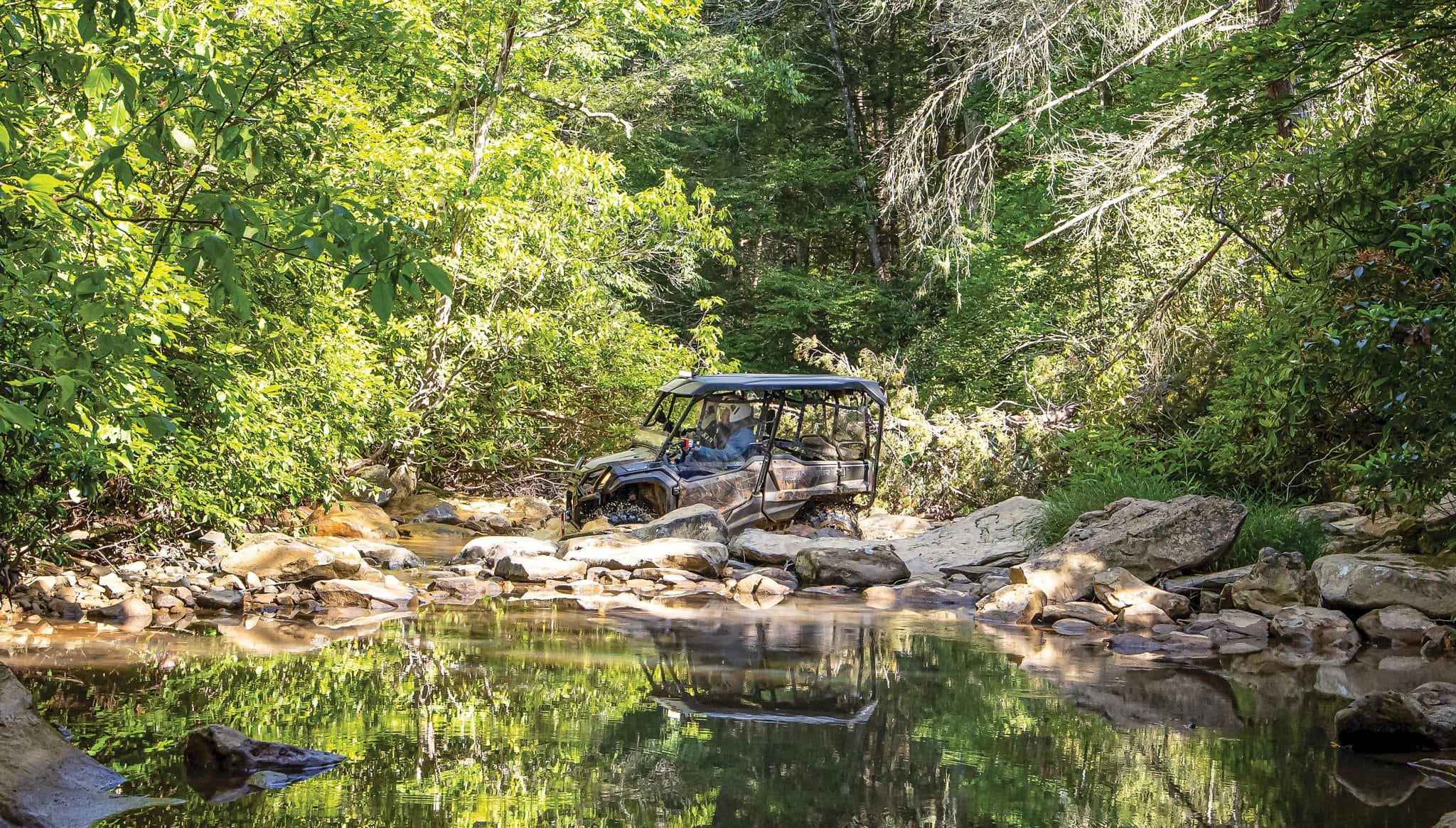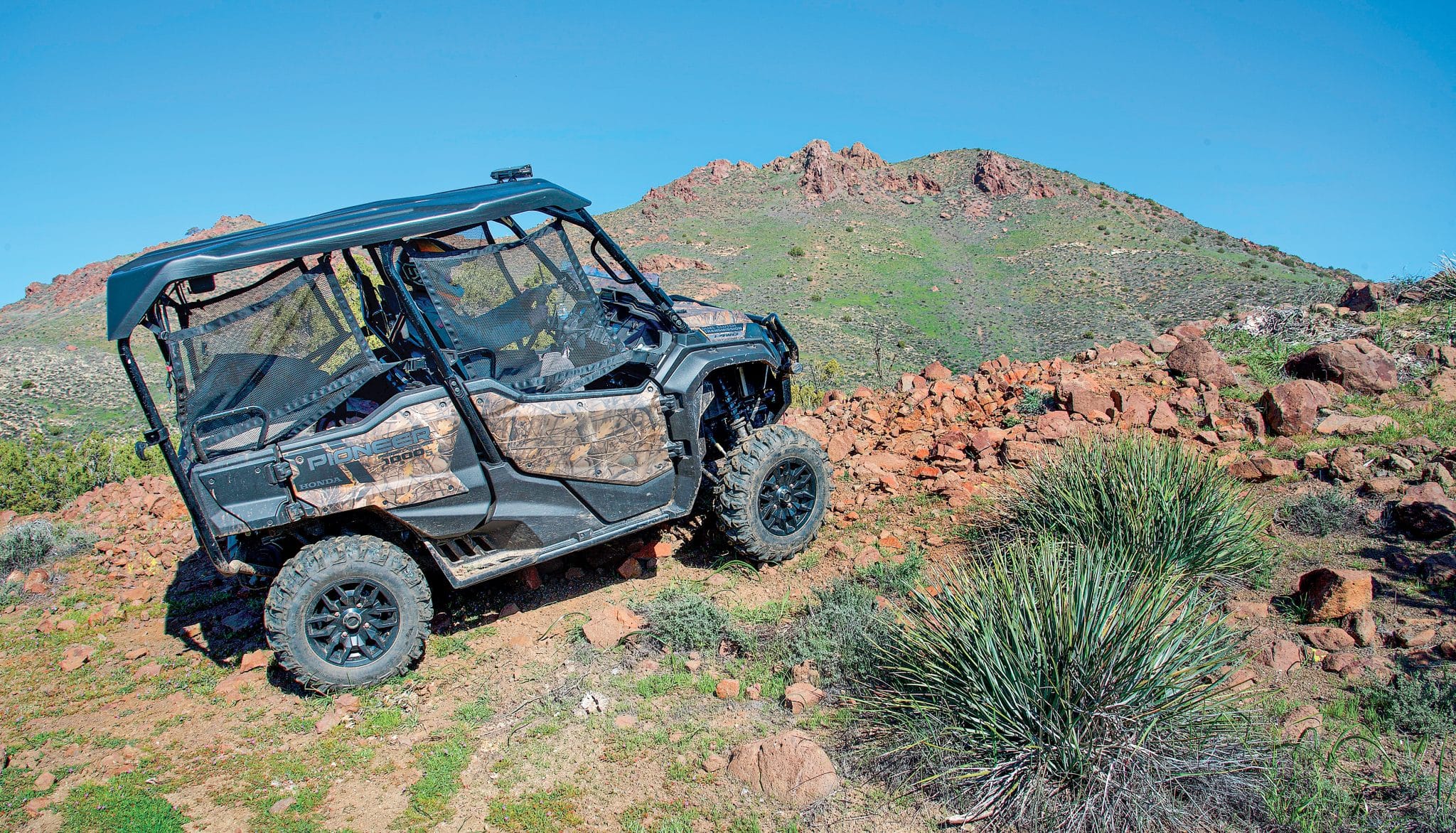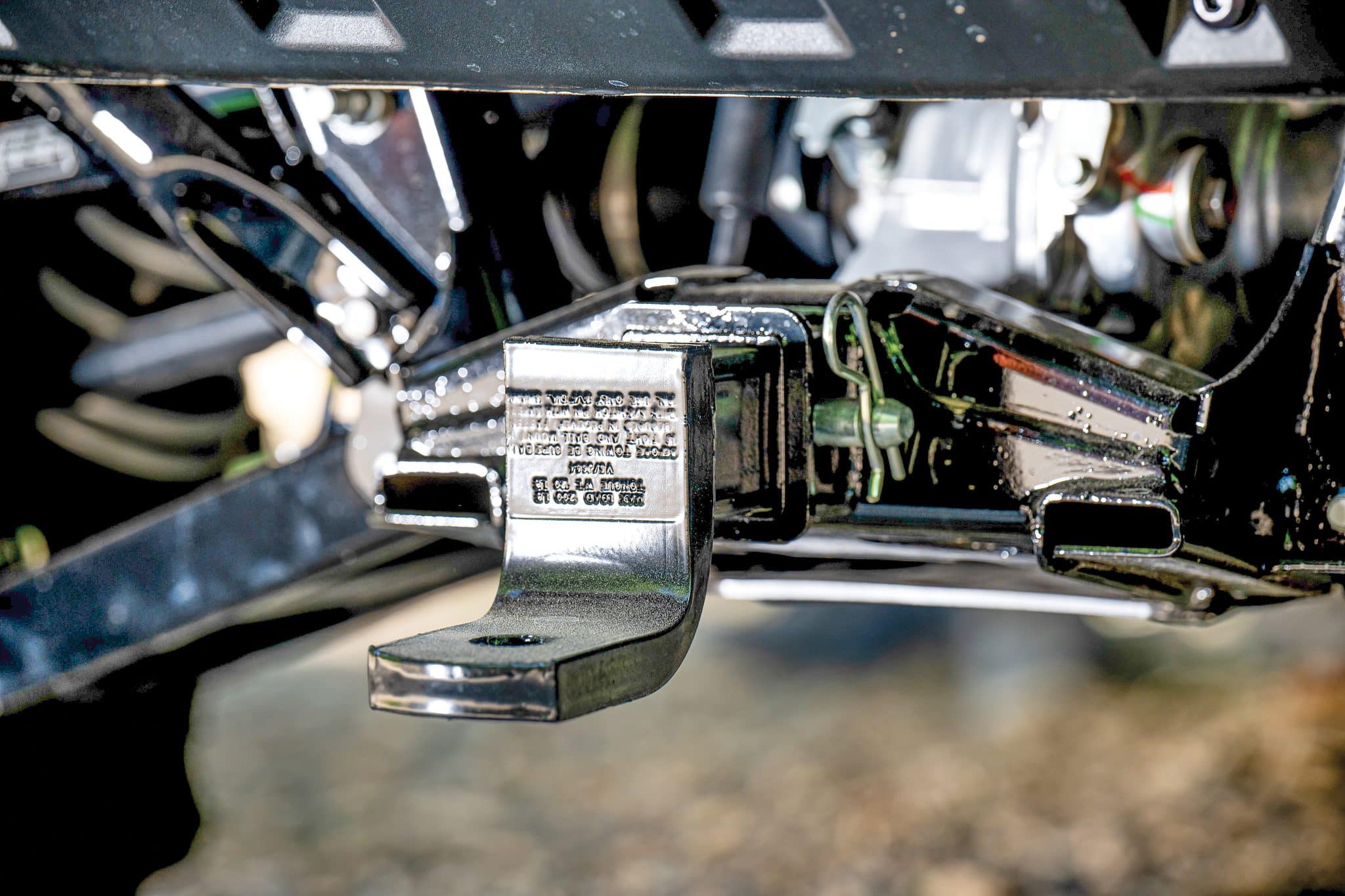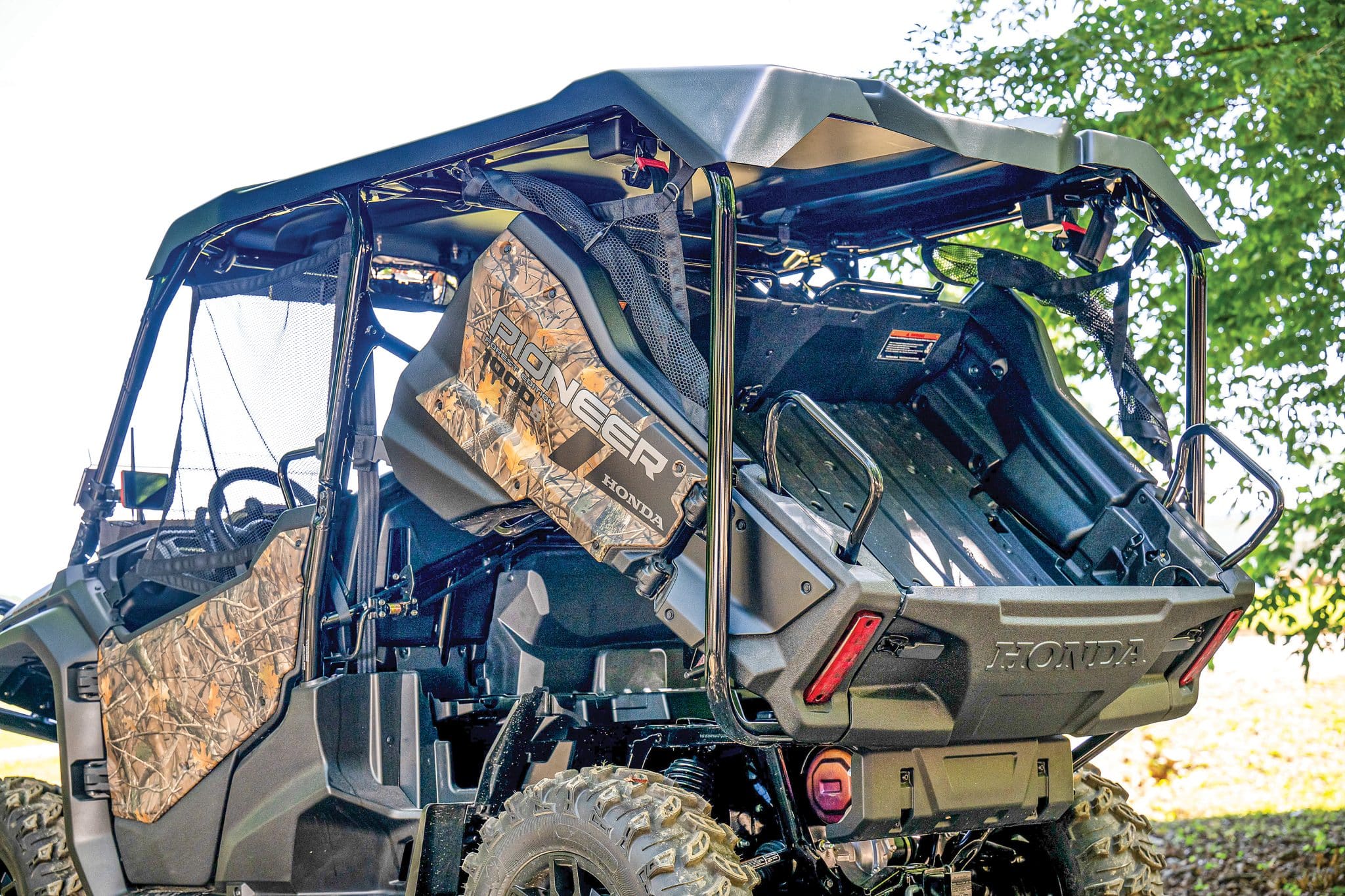TEST: 2023 HONDA PIONEER 1000-5 FOREST
A different shade of Pioneer we know and love
By the staff of Dirt Wheels

We’ve tested every version of Honda’s Pioneer the last handful of years, most notably the addition of the welcome 1000cc machine in 2017. One of the latest updates is the nicely appointed Pioneer 1000-5 Forest Edition five-seater. If you couldn’t tell already, this model is blatantly styled for outdoorsmen and hunters.
Honda has a unique niche with the Pioneer line. They are incredibly capable, utility-wise, with a 2500-pound towing capacity—maybe the most capable in that rec/utility category. We really appreciate how it can handle all of our gear on the trails and continue to handle with precision. Some companies have leaned more heavily towards the performance side, while Honda has reached an equal balance of work and play. For this machine, we had a chance to try it out in more adverse conditions with the well-above-average rainfall we’ve been having in SoCal. We put the motor through grueling tasks in muddy conditions, and managed to open up the throttle on a few trails and fire roads. We even took it to the dunes as a support vehicle.
WHAT’S HUNTING ABOUT IT
Phantom Camo gives away the identity of Honda’s intended customer. However, there are some other practical features that are also great for hunting, as well as camping or simply having fun on the trails. A standard 4500-pound-rated Warn winch will get plenty of use, whether you’re stuck in deep mud or need to tow a downed tree out of the trail. We didn’t do any hunting, but we did use the winch to assist pulling our truck out of some sticky mud with ease.
It’s not specific to hunting, but the box setup on the Forest, Trail, and Deluxe editions’ under-seat storage has been enlarged at the opening. That makes life much easier when stowing and removing accoutrements. Storage areas below the dash were enlarged in 2022, and items are secured with built-in cargo nets. And although it may be a tight fit all suited up and loaded down with gear, you can fit five people in the cab. If all passengers are adults, four is a more comfortable and realistic number.

SHARED FEATURES
Many features have remained on the Pioneer 1000 since 2017. Changes to the Trail and Forest editions include a restyled front end, including lighting.
The Pioneer 1000 shares engine architecture with the Talon sport UTV and the Africa Twin adventure motorcycle. 2022 saw the Pioneer get more power in the middle and upper rpm ranges by changing up valve timing and updating the throttle-body plate setting. Towing capacity was brought up to 2500 pounds, where the change was noticeably beneficial at lower rpm while in low range. We were pulling a heavy drag to groom a dirt driveway, and even when going through slippery mud, the Pioneer didn’t even break a sweat.
Cooling-fan size has been increased correspondingly. We didn’t notice the wider-ratio changes made in 2022, but we like the smoother-shifting action between gears. The transmission isn’t exactly seamless when it comes to going through the gears, but it isn’t as abrupt as the previous generation of Pioneers.
A pre-wired panel under the hood helps simplify installation of electronic accessories. And, the top-of-the-line Pioneer models have pre-wired switches integrated in the dash for additional accessories. There is also a 12-volt accessory receptacle in the bed to power 12-volt devices, perfect for sprayers and other agricultural implements. The Trail has interior lights as well, and they’re sufficient for night riding.
FEATURES OF THE COCKPIT
Seating is a big selling point with this machine, especially if you have a family or group of friends who often join you. The five-seater just offers more inclusion. Obviously, five people in the Pioneer isn’t a problem, power-wise, but it can be a little cramped with full-size humans. You get three seats on the contoured front bench seat and two on the hidden rear seats. The two rear seats fold down and become part of the bed floor when required to carry cargo. Surprisingly, the fold-out rear seats are comfortable.
Like the Trail edition, the Forest got a new dash-meter aesthetic with added functions, including a clutch overheat indicator, battery voltage and CAN communication. If dust buildup stays at a minimum, the display is plenty bright. Controls for the drive modes are on the dash as well. A gated lever allows you to select between 2WD, 4WD and Turf mode. The DCT transmission allows you to jump between automatic shifting, Auto Sport mode and manual shifting, with a selector switch on the dash. Manual shifting is accomplished with steering column-mounted paddle shifters. Engaging Sport mode lets the engine rev higher before shifting, and downshifts happen sooner for a more aggressive feel. Whether in sport mode or normal auto, you can override the auto shifting somewhat with the paddle shifters. Typically, we downshifted for corners to allow better response and upshifted to ease engine braking for descents.

CHASSIS
All Pioneer 1000 versions come with 14-inch wheels, and on the Forest Edition, they are blacked out. Upgraded OTR Dirt Master 6-ply tires (4-ply in 2021) became standard in 2022.
Of all the Pioneer 1000 versions, the Trail Edition is the only one that comes with Fox Quick Switch 3 (QS3) shocks. The Forest Edition has preload-adjustable gas-charged shocks, but the rears are cleverly self-leveling. In other words, they adjust the ride height automatically for additional passengers or cargo. Our initial testing was at Tennessee’s Ride Royal Blue OHV park. The well-marked trail routes didn’t tax the suspension, but the routes were choppy and rutted enough to slow our trail speeds. It was rare that we experienced smooth trail sections for any distance. Under those conditions, we missed the adjustability of the Fox shocks. For less taxing routes or when working, the self-leveling shocks were an advantage. We traversed a few miles of rolling whoops connecting sections in the dunes, but it was necessary to keep the speed in check to prevent bucking.
WHAT IS I-4WD?
All 2022 and 2023 Pioneer 1000 versions come standard with Honda’s torque-biasing, limited-slip rear differential. Turf mode frees the rear differential to protect lawns and other sensitive surfaces. Honda’s all-terrain division worked with Honda automotive engineers to come up with i-4WD. It offers the traction advantages of a differential lock without the typically hard steering.
When you select 4WD with the dash-mounted lever, you are selecting i-4WD (“intelligent four-wheel drive”). Normal differential lock is obvious with firm steering input required and front wheels that remain spinning together while in the air. In contrast, i-4WD feels normal, but Honda has employed a bunch of technology to make it work seamlessly. The system routes torque to the wheels that have the most traction. Honda has a demonstration fixture that puts three wheels on roller bearings with a single front wheel forced to climb a steep metal ramp. One front wheel hangs in the air as the car climbs, but none of the wheels spin. In use, when one front wheel starts to slip or lose traction, the system brakes the spinning wheel and routes additional power to the wheel that has traction.
This system could not work without Honda’s brake-traction control managing the amount of slip between the two front wheels and increasing torque where there is more grip. Steering effort is low, and there is little kickback compared to standard locking differentials.
In addition to managing front-wheel traction while driving, brake-traction control automatically adjusts braking forces between the front and rear wheels. The wheels with the best traction get the most braking power. The Pioneer Forest stops great, but unlike typical automotive ABS that is horrible on loose terrain, you never feel the computer managing stopping power with that uneasy brake-pumping feel. Like i-4WD, it simply works. There is no need to stop to engage diff-lock.
The Pioneer Forest also has hill-start assist. It will hold the machine on a hill without the driver having to stand on the brake. It’s a handy feature when riding with large groups.

MOTOR
With the revised gear ratios and engine updates, throttle response is instant, but with the controllable and easily modulated power delivery you want for utility work. Out on the trail, acceleration is peppy for whipping through the trees or aggressive four-wheeling. Acceleration is well matched to the suspension and tires, with little wheelspin when you mash the accelerator pedal.
The terrain at Ride Royal Blue allowed for full-throttle operation for only the shortest intervals. Out west, we had dirt roads and routes that encouraged a much quicker pace.
At Dumont Dunes, we kept to easy routes and smallish dunes, but the Pioneer wasn’t as happy. Traction in the sand was limited (though excellent over rocks and on firm terrain), and there was some wheel hop. The light signaling DCT clutch overheating was almost constant. It is not a dune shredder, but it handled faster routes on dirt happily enough.

TRANSMISSION TIME
The Honda’s Dual Clutch Transmission (DCT) is an all-gear six-speed with two clutches and no CVT or drive belt. One clutch manages the even-numbered gears and the other clutch the odd-numbered gears. As one gear approaches maximum rpm, the next gear is already engaging. Whether you let the Honda shift for you, or you manually select the gear with the paddle shifters, the engine management package ensures that each gear engages smoothly. You feel satisfying acceleration and a new surge with each shift.
For work and casual driving, we selected auto mode, but for trail driving, we selected manual mode and employed the paddle shifters. In manual mode, you don’t have absolute control. The computer will not allow the engine to stall, so if rpm drop too low, it downshifts for you. On the automatic setting, you can use the paddles to grab a quicker, more immediate shift up or down.
Honda’s DCT offers immediate and true engine braking, and it is heavy at times. That is great if the trail conditions demand a slow descent. For faster or longer descents, we preferred upshifting to minimize the engine braking.

THE VERDICT
The transmission aspect of the Pioneer is most different compared to other UTVs, and it takes some learning to get the most out of it. However, we appreciate that Honda has improved the transmission, making it a little smoother. We commend Honda for the way they utilized the space in the cab for more occupants while retaining the utility convenience of a dump bed. The seats can be folded up or down to feel very secure and fairly comfortable. Unless we had a compelling reason to carry tall items in the bed, we would always opt for the five-seat version. The protective cage ends at the back of the cab on the three-seat version, so it does allow a greater variety of options when using the bed. Whichever Pioneer you choose, rest assured you have a well-engineered machine with proven reliability and longevity, in addition to spry handling and sport-like performance.
PIONEER 1000-5 FOREST
Engine type Liquid-cooled, four-stroke, four-valve, Unicam parallel-twin
Displacement 999cc
Bore x stroke 92.0 x 75.15mm
Fuel system EFI
Fuel capacity 7.9 gal.
Starting system Electric
Final drive 6-speed dual-clutch transmission with P/R/N/H/L
Suspension/wheel travel:
Front Dual A-arms w/preload adjustable shocks /10.6”
Rear Dual A-arms w/self-leveling shocks/10.0”
Tires:
Front Armstrong Dirt Master 27×9-14
Rear Armstrong Dirt Master 27×11-14
Brakes:
Front Dual 210mm hydraulic discs
Rear Dual 210mm hydraulic discs
Wheelbase 80.2”
Length/width/height 119.2”/63”/76.5”
Ground clearance 12.3”
Payload capacity 1,000 lb. (600 lb. for CA models)
Towing capacity 2,500 lb.
Curb weight 1,777 lb.(wet)
Colors Phantom Camo
MSRP $21,499



Comments are closed, but trackbacks and pingbacks are open.